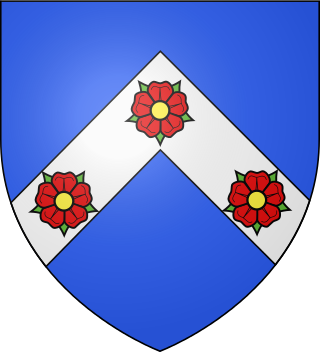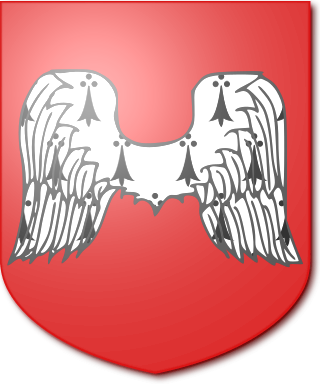
Edmund Blackadder is the single name given to a collection of fictional characters who appear in the BBC mock-historical comedy series Blackadder, each played by Rowan Atkinson. Although each series is set within a different period of British history, all the Edmund Blackadders in the franchise are part of the same familial dynasty. Each character also shares notable personality traits and characteristics throughout each incarnation. In a 2001 poll conducted by Channel 4, Edmund Blackadder was ranked third on their list of the 100 Greatest TV Characters.

Lord Polwarth, of Polwarth in the County of Berwick, is a title in the Peerage of Scotland. It was created in 1690 for Sir Patrick Hume of Polwarth, 2nd Baronet, Lord Chancellor of Scotland from 1696 to 1702. In 1697 he was further created Lord Polwarth, of Polwarth, Redbraes and Greenlaw, Viscount of Blasonberrie and Earl of Marchmont, also in the Peerage of Scotland. Upon the death of his grandson, the third Earl, the creations of 1697 became dormant (unclaimed).
Viscount of Kenmure was a title in the Peerage of Scotland. It was created by Charles I in 1633 for the prominent Presbyterian Sir John Gordon, 2nd Baronet. He was made Lord Lochinvar at the same time, also in the Peerage of Scotland. Both titles were created with remainder to "heirs male whatsoever bearing the arms and name of Gordon"

Sir Robert Grierson, 1st Baronet of Lag was a Scottish baronet from Dumfriesshire.

The Grange is an affluent suburb of Edinburgh, just south of the city centre, with Morningside and Greenhill to the west, Newington to the east, The Meadows park and Marchmont to the north, and Blackford Hill to the south. It is a conservation area characterised by large early Victorian stone-built villas and mansions, often with very large gardens. The Grange was built mainly between 1830 and 1890, and the area represented the idealisation of country living within an urban setting.
The baronetcy of Cuninghame of Corsehill was created in the Baronetage of Nova Scotia and conferred upon Alexander Cuninghame of Corsehill, a Scottish baron and landowner in Dumfriesshire and a great-great-great-grandson of the 4th Earl of Glencairn. The fourth baronet's father added the name Montgomery before his own on inheriting the estate of Kirktonholm.

Clan Johnstone is a Border Reiver Scottish clan.

The Dalyell Baronetcy in the Baronetage of Nova Scotia was created 7 November 1685 for a Scottish General, Thomas Dalyell of the Binns. The succession of the title is unusual in that, in default of heirs male, it can pass by special remainder to tailzie succeeding him in the estate of The Binns.

Clan Moncreiffe is a Highland Scottish clan.

Allanton is a small village in the Scottish Borders region of Scotland. Historically part of Berwickshire, for many years it was part of the estate of Blackadder House, which was demolished around 1925.

Tulliallan was an estate in Perthshire, Scotland, near to Kincardine, and a parish. The Blackadder lairds of Tulliallan, a branch of the Blackadder border clan, wielded considerable power in the 15th and 16th centuries. The modern Tulliallan Castle is relatively recent, built in 1812-1820 and now the home of the Scottish Police College
There have been five baronetcies created for persons with the surname Home, four in the Baronetage of Nova Scotia and one in the Baronetage of the United Kingdom. Only one creation is extant as of 2008.

Clan Blackadder is a Scottish clan. The clan historically held lands near the Anglo-Scottish border.

Sir Lachlan Maclean, 1st Baronetof Morvern, was a Scottish nobleman and the 17th Chief of Clan Maclean. He was granted his Baronet title by Charles I and he became the Clan Chief on the death of his brother in 1626. He fought as a Royalist under James Graham, 1st Marquess of Montrose during the Wars of the Three Kingdoms at the Battle of Inverlochy, Battle of Auldearn and Battle of Kilsyth. From 1628 to 1633 he sat in the Parliament of Scotland as shire commissioner for Tarbert. From his rule onward, all Maclean clan chiefs are successive Baronets of Movern.

The Rayney Baronetcy, of Wrotham in the County of Kent, was a title in both the Baronetage of Nova Scotia and the Baronetage of England. It was first created in the Baronetage of Nova Scotia on 19 December 1635 for Sir John Rayney of Wrotham Place, Wrotham, Kent. He was then created a Baronet in the Baronetage of England on 22 January 1642, with the same territorial designation. Rayney's father John Rayney, of West Malling, was a merchant and Alderman of London who bought Wrotham Place which became the family seat. The first Baronet had been knighted at the Coronation of Charles I in 1626. He served as High Sheriff of Kent in 1646. On the death of the fifth Baronet in 1721 the English baronetcy became extinct while the Scottish baronetcy became dormant.
The Governor of Stirling Castle was the military officer who commanded Stirling Castle, in Scotland. Control of the castle frequently passed between the Scots and the English during the Wars of Scottish Independence. The castle's military character was maintained for several centuries, the last siege occurring in 1746 during the Jacobite risings. It continued to be used as a military barracks until 1964.
John Blackadder or Blackader may refer to:

John Blackadder (1615–1685) was an eminent Presbyterian Covenanter preacher in Scotland during the period of the Commonwealth of England (1649–1660). Of the times MacPherson said that "after the first rejoicings of the Restoration were over, the Covenanters — Resolutioners as well as Protesters — were speedily disillusioned, and it became evident that the aim of Charles II and the junta of self-seeking noblemen who were in control of the affairs of Scotland was to establish in Scotland something approximating to an oriental despotism. The Presbyterian system, in which an Assembly of ministers and elders controlled the affairs of the Kirk, had to be supplanted by an Episcopal, with a hierarchy controlled by the Crown and easily manipulated in the interests of tyrannical rule." Despite a government ban he continued to preach in the fields. He was arrested and imprisoned in 1681 and died in jail on the Bass Rock.

Blackadder House was an estate and stately house near the village of Allanton, in Berwickshire, Scotland. It was built on the site of the earlier Blackadder Castle. The house was vandalised by troops in World War I. Since there was no money to repair it, the house was demolished around 1925.
Sir Richard Graham, 1st Baronet of Esk was an English politician elected to the House of Commons. He fought in the English Civil War for the royalist army.














